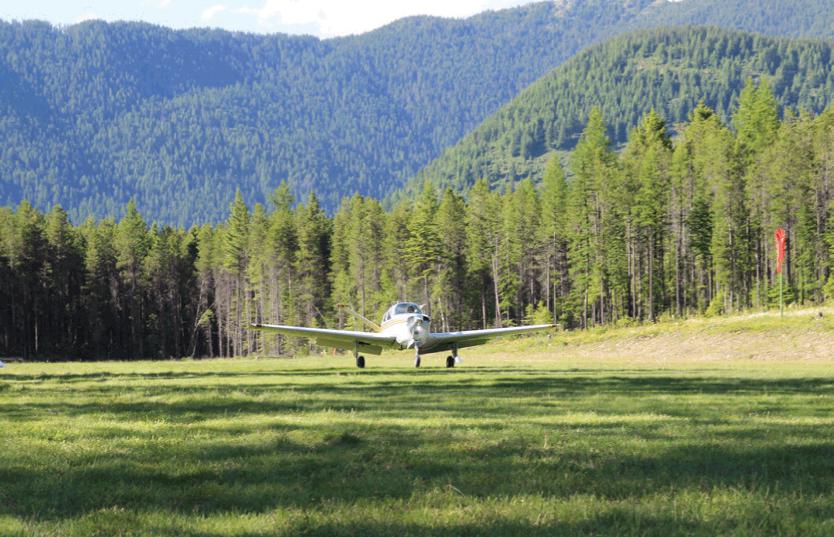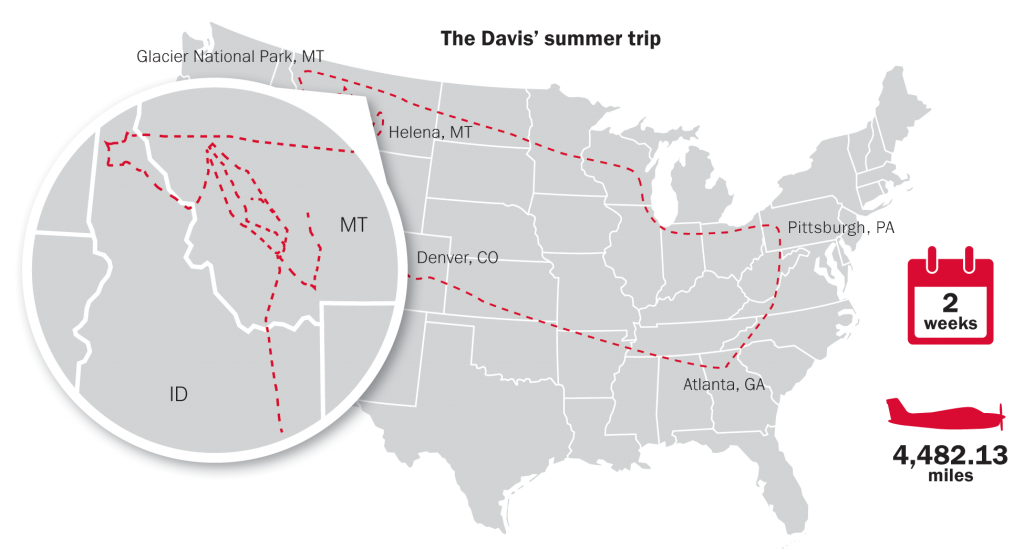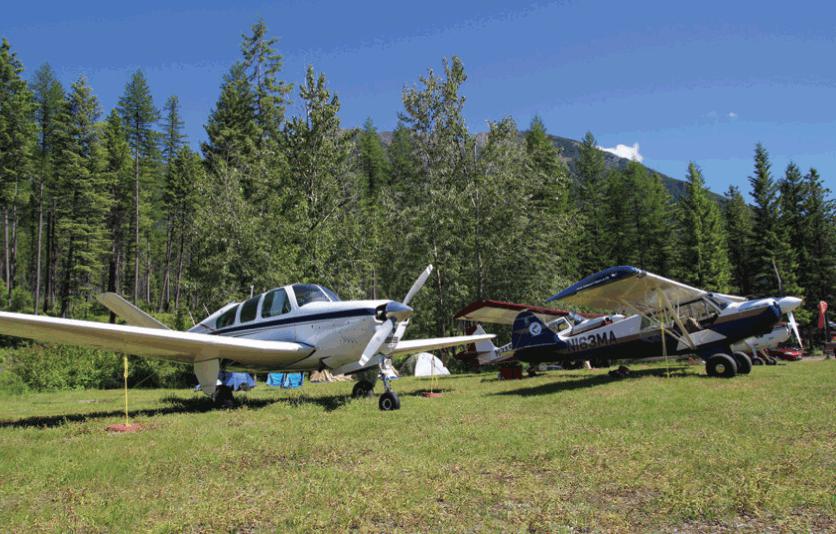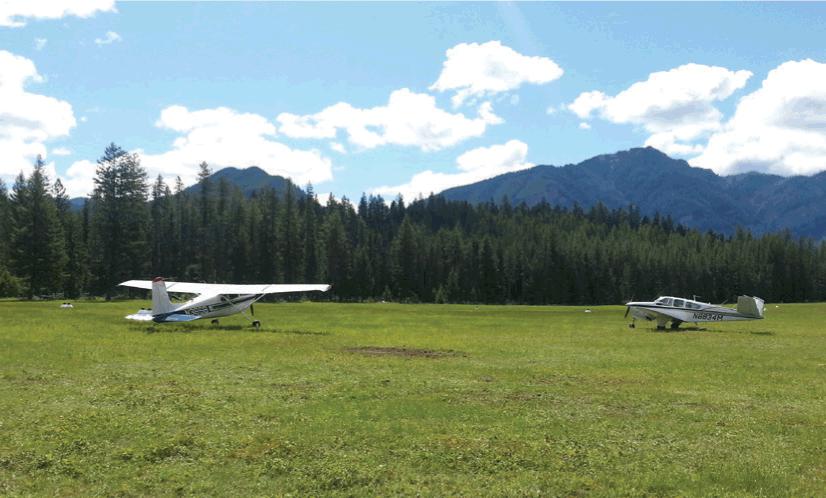↩ Back
Flying the backcountry in a single-engine aircraft
A life-changing journey for one Bonanza pilot
Aviation outposts like Benchmark and Cavanaugh Bay will never be confused with LaGuardia, LAX or even Atlanta’s Hartsfield-Jackson Airport where Eric Davis and a group of his boyhood friends once roamed the terminal imagining themselves as world travelers.

Eric Davis began his 17-day mountain adventure in late June 2013. By the time he was done, he’d logged a “life-changing experience.”
A simple airstrip with a simple name like Schafer Meadows contains none of the traffic and congestion of major metropolitan airports. Tucked in the wilderness of northwestern Montana, its grass runway is nestled in dense timber below the peaks of the Swan Mountains, with the Middle Fork of the Flathead River flowing nearby.
For Davis, an engineer for a Petaluma, California-based telecommunications company, these remote destinations were perfect matches for his adventurous spirit. Over the course of two weeks in the summer of 2013, Davis piloted his Model 35 Beechcraft® Bonanza® through the backcountry of Montana and northern Idaho.

“I’m not one to say many things are life-changing,” Davis said. “But I guess I can say this was.”
Mountain flying has quickly evolved from a bucket-list item to a passion for Davis since he purchased his first aircraft, acquiring a 50-percent share of the V-tail Bonanza from an Atlanta partner in 2011. Davis began flying in 2003, using some holiday time off to take flying lessons. He eventually earned his private pilot license.

Eric Davis documented the beautiful mountains from every angle.
Davis received his instrument rating after purchasing the Bonanza and has flown the aircraft for business, personal and charitable purposes. He and his wife, Maureen Carroll, travel from Atlanta to the Pittsburgh area five or six times a year to visit her family. Davis has also participated as an Angel Flight volunteer, serving an organization that provides free travel to people for medical-related needs.
Along the way, Davis began researching ways to connect his love for air travel with his and Maureen’s enjoyment of the outdoors.
“I got bored flying from one concrete airport to the next,” Davis said. “Early in 2012, I learned about the Recreational Aviation Foundation (RAF) and their preservation and creation of backcountry airstrips nationwide.”
The idea of flying a nearly 50-year-old, single-engine aircraft through canyons and mountainous terrain was met with skepticism by many of Davis’ fellow pilots, but he devoted numerous hours reading about the challenges and rewards of backcountry flying and participated in discussions with pilots in online forums.
In June 2013, Davis set out for the RAF’s Member Fly-In at Ryan Field near Glacier National Park in Montana. Before his arrival, he arranged to spend a day with Jeanne MacPherson, owner of Mountain Airdance Flight Instruction in Helena, Montana.
MacPherson, a certified flight instructor, formerly served as Bureau Chief of Safety and Education for the Montana Department of Transportation’s Aeronautics Division. As chief pilot, she coordinated air search and rescue operations, promoted aviation education and taught mountain flying. Her background includes extensive mountain flying in a Beechcraft Bonanza A36.

Part of Eric Davis’ two-week excursion was a fly-in where he joined other pilots who enjoy flying through the backcountry.
“We spent a few hours talking about our various flying experiences,” said Davis, who serves as Georgia’s RAF liaison. “With me coming from back east and doing most of my flying close to sea level, she asked me, ‘What’s your typical final approach airspeed? One hundred knots? Because that’s not going to work out here.’”
MacPherson took Davis to a practice area where he focused on flying the Bonanza at lower speeds.
“I gained a new appreciation for the handling characteristics of the Bonanza. Learning how to fly the plane slow enough to execute a 180-degree turn in a tight canyon emphasized the Bonanza’s superb handling at slow indicated airspeeds.”
Eric Davis, backcountry pilot
A byproduct of lower airspeed is a quieter aircraft. In mountain flying, a reduced noise signature is another point of emphasis.
“She stressed the concept of backcountry etiquette,” Davis said. “Don’t fly at high power settings, reduce your propeller revolutions, those types of things.”
“You just want people to understand it’s a privilege to use those places. There are places with backcountry strips on national park lands. You don’t want to use those places for practice. They are noise-sensitive areas, and they are very valued resources.”

Eric Davis credits the craftsmanship of his Beechcraft Bonanza for its ability to land beautifully, even on grass runways.
Davis said the high density altitudes make mornings the optimal time for mountain flying. After a day of instruction with MacPherson, he began a solo journey from Helena toward the Schafer airstrip and eventually on to Ryan Field for the fly-in. His wife joined him for the remainder of the adventure.
“Landing in a remote wilderness and being immediately surrounded by rugged mountains adjacent to pristine streams was truly awe inspiring,” Davis recalled. “On the ground, I was able to fish, hike, sleep undisturbed, read a book or simply take it all in. And while camping under the wing of a Bonanza is not really practical, I did enjoy looking out of my tent each morning to see the trusty V-tail.”
Davis knows the history of the Bonanza and its continuous production since 1947. His backcountry experience added to his appreciation of its craftsmanship. It is a feeling shared by Maureen, an industrial designer who owns a product design business.
“You just need to understand the equipment you have,” Davis said of advice he would give prospective backcountry pilots. “When I was looking into buying this, the type of airplane was a tertiary consideration. I really feel like I lucked out with the Bonanza.”
“I’ve really started to appreciate the craftsmanship. I do all the owner maintenance, and I’ve come to appreciate the quality of the construction. These planes were designed at a time when unimproved airstrips had to be the norm. They were really made for this type of flying.”